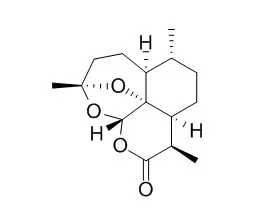| In vitro: |
| Z Naturforsch C. 2010 Sep-Oct;65(9-10):607-12. | | Bioconversion of artemisinin to its nonperoxidic derivative deoxyartemisinin through suspension cultures of Withania somnifera Dunal.[Pubmed: 21138064] |
METHODS AND RESULTS:
Biotransformation of artemisinin was investigated with two different cell lines of suspension cultures of Withania somnifera. Both cell lines exhibited potential to transform artemisinin into its nonperoxidic analogue, Deoxyartemisinin, by eliminating the peroxo bridge of artemisinin. The enzyme involved in the reaction is assumed to be artemisinin peroxidase, and its activity in extracts of W. somnifera leaves was detected.
CONCLUSIONS:
Thus, the non-native cell-free extract of W. somnifera and suspension culture-mediated bioconversion can be a promising tool for further manipulation of pharmaceutical compounds. | | Acta Prataculturae Sinica, 2015, 24(11):29-37. | | Artemisinin and flavonoids in wild Artemisia annuaand surrounding soil and the influence on soil microbes[Reference: WebLink] | Artemisia annua releases various kinds of allelochemicals into soils via rain leaching,root exudation and dead tissue decomposition during the growing season,with resulting inhibition of the growth and development of adjacent plants and succeeding crops.
The present experiments were thus conducted to detect artemisinin derivatives,flavonoids and effects on soil microbes in wild A.annuaand surrounding soil.
METHODS AND RESULTS:
The allelochemical concentrations ranked:bud break periodearly flowering periodfull bloom periodvegetative growth period(artemisinin in leaves and root zone soil)and stemleafrootflower(flavonoids in plants).In sampled soils,the mean concentration of Deoxyartemisinin was highest,followed by artemisic acid and artemisinin in soil and the sum of these artemisinin derivatives was 516.93μg/kg dry soil.Concentrations of all three compounds tested were highest in root surface soil and much higher in the root surface soil and rhizosphere soil than in non-rhizosphere soil.Soil flavonoid concentrations increased steadily during the growing season of A.annua and reached their highest levels at full-bloom stage(434.77μg/kg dry soil).
CONCLUSIONS:
Hence it is concluded that flavonoids are released into soils through root exudation.The numbers of bacteria and actinomycetes showed significant negative correlations with artemisinin concentration(r=-0.508*and-0.478*,n=24).There was also a negative correlation between deoxyartemsinin contents and actinomycete numbers(r=-0.528**,n=24).In summary,artemisinin and its derivatives released fromA.annuaappear to inhibit microbial growth and reproduction,and are therefore likely to influence biochemical reactions in soils. |
|






 Cell. 2018 Jan 11;172(1-2):249-261.e12. doi: 10.1016/j.cell.2017.12.019.IF=36.216(2019)
Cell. 2018 Jan 11;172(1-2):249-261.e12. doi: 10.1016/j.cell.2017.12.019.IF=36.216(2019) Cell Metab. 2020 Mar 3;31(3):534-548.e5. doi: 10.1016/j.cmet.2020.01.002.IF=22.415(2019)
Cell Metab. 2020 Mar 3;31(3):534-548.e5. doi: 10.1016/j.cmet.2020.01.002.IF=22.415(2019) Mol Cell. 2017 Nov 16;68(4):673-685.e6. doi: 10.1016/j.molcel.2017.10.022.IF=14.548(2019)
Mol Cell. 2017 Nov 16;68(4):673-685.e6. doi: 10.1016/j.molcel.2017.10.022.IF=14.548(2019)